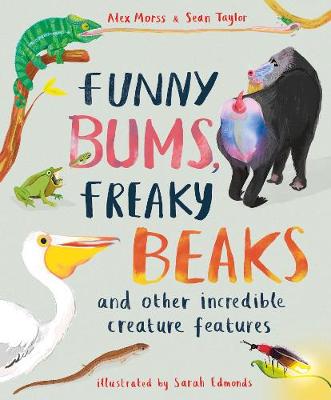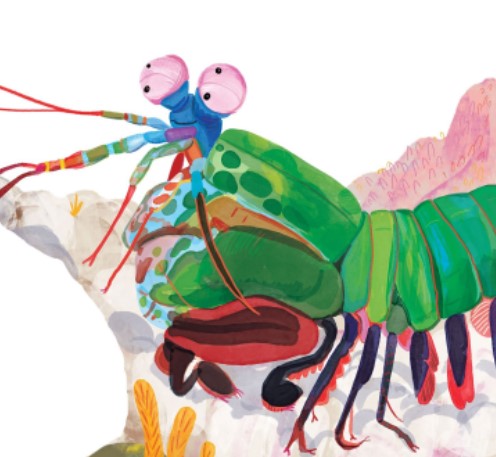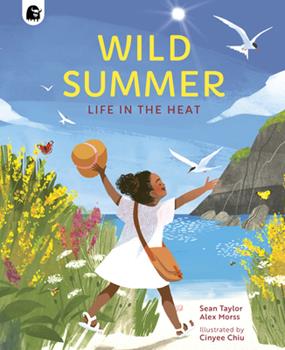
FUNNY BUMS, FREAKY BEAKS and other incredible creature features is out in paperback. Find out all about how I co-wrote this much-love information book in an interview I recently did, first published on the ‘My Shelves are Full’ website. Also includes news of fresh writing projects with ecologist, Alex Morss…
First and foremost, what a brilliant book this is! The title is fantastic and sure to capture interest immediately. Did the title come early on in the writing of the book?
Thanks. It does feel like a unique book, and it was a total team-effort, putting it together. Each of us contributed different know-how and skills, to make the project special.
Yes, Alex Morss and I came up with the title long before we started work on the text,or got the publisher interested. After coming up with the idea for the book, Alex Morss and I sat down together to brainstorm a list of chapters. Each was based on a piece of animal anatomy that can be strange and wonderful, in certain species. We thought up STRANGE TAILS, TERRIFIC TEETH, PUZZLING TOES… And when arrived at FUNNY BUMS, it jumped out as the one that would make an eye-catching title.
We paired it up with FREAKY BEAKS. And the title of our book was born: FUNNY BUMS, FREAKY BEAKS and other incredible creature features!
Celebrating diversity and difference is important and highlighting differences with animals is a great way to share this message with readers- was this always the intent of the book?
Yes, absolutely. From the word go, we wanted the book to fly in the face of negative judgements about being different. We show, again and again and again, that difference in nature – strangeness, weirdness, extremeness – is there because it’s positive for the animal in question.
A rattlesnake has an unusual tail because the tail helps it survive. A male wild turkey has a very different kind of neck because its eye-catching dangly bits help him attract a mate. A sun bear has a freaky tongue because it helps her eat what some animals can’t reach. As we say in our introduction, “Nature’s diversity makes planet Earth a richer, more beautiful place.’
How much research did you do for the book?
Both identifying the best animals to include in the book and selecting the most interesting information about them, required a lot of research.
We were helped by the fact that my writing partner, Alex Morss, has an encyclopaedic knowledge of the natural world, resulting from decades of studying biology, doing field work, and writing about ecology. It was amazing how much information she was able to come up with, simply off the top of her head!
But Alex is also extremely careful about getting facts right. This meant she spent many additional hours properly checking every fact in the book – and not just by searching on the internet, which is home to much false information and can’t be fully trusted.
Because our research was thorough, we’re confident that all the information is spot-on. (At least we haven’t had a single complaint about it, in the year since the book came out in hardback!)
How long did it take you and Alex Morss to research and write the book?
It was a tremendous amount of work. We ended up writing about 107 different species!
We worked at writing the book for the best part of a year, with an intense spell of about 6 months, in which we dug deep into the research and drafted the various chapters … then redrafted them, and redrafted them again.
Although it was a demanding task, it was made easier by the fact that the subject matter is so fascinating.
Was there something you learned during research which surprised you?
Nearly everything surprised me! I was on the team as the one specialised in creative writing and book-making for young readers. Alex, as well as being an ace writer, was the one suggesting the species we should write about, and coming up with most of the information about the animals.
In every chapter, there were facts I didn’t know, statistics which took me by surpriseand species I’d never come across. These included the shocking blue tongued lizard, the goofy eastern long-necked turtle and (my favourite animal in the book) the extraordinary peacock mantis shrimp.

The illustrations are so appealing for many ages and share some of the weird and wonderful features of animals- what did you think when you first saw these?
We knew we had a very talented artist on board, in Sarah Edmonds. But we were still very excited by the life, child-friendly appeal, and beauty she put into her final illustrations.
Doing the artwork for a book like FUNNY BUMS, FREAKY BEAKS and other incredible creature features requires two skills. Firstly, a technical ability to bring to life a range of little-known animals, with scientific accuracy. Secondly, a creativeability to make characterful artwork that children will find engaging. Some illustrators would be good at one of these two things. Sarah Edmonds is great at both.
Were there any animals who didn’t make it into the book?
The natural world is so rich in wonders that for every chapter we quite easily came up with more species than would fit into the space allowed!
It was hard to choose what to leave out. Sometimes we did a good bit of research about a particular species, and even wrote what we wanted to say about it, but then realised it would have to fall by the wayside.
Examples of some of the animals we ended up cutting: a squid in FREAKY BEAKS, a chameleon in EXTRAORDINARY EYES, an ostrich in PERPLEXING NECKS, and a blob fish in ODD NOSES.
Incidentally, we also cut a number of whole chapters that were a part of the original plan. This included WHACKY WINGS and CRAZY CLAWS!
Are you and Alex planning more books together in the future?
It’s been a fruitful partnership and we have a new book coming out on 28th June this year. It’s called WILD SUMMER, and it’s the third book in a series about life in the different seasons. Each of the books (aimed at 5- to 8-year-olds) features an imagined story and an information section.
First of all, we wrote about how plants and animals cope with the cold, in a book called WINTER SLEEP.
Then, last year, we published a book called BUSY SPRING, which explains the big ‘wake-up’ for nature in springtime.
Now WILD SUMMER brings to life the ways nature copes with heat and extremeweather conditions – both of which are typical of summer, and both of which arebecoming more dangerous because of climate change.

